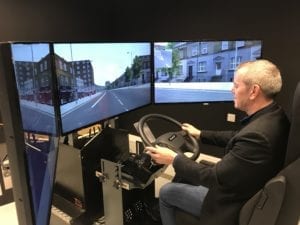A £6m investment in painted zebra crossings at 20,000 side roads within Greater Manchester’s 1,800-mile walking and cycling network could save the region £23m per year, a study has claimed.
Interim results from an ongoing study being conducted by the Transport Research Laboratory (TRL) on behalf of Transport for Greater Manchester (TfGM), seeks to gather evidence to support a case for allowing the use of a stripped-down version of the zebra crossing.
The study claims that the UK-invented zebra crossing is “near-universally recognisable” to walkers and drivers alike, even without zig-zag markings and Belisha beacons, which are currently required.
According to the study, at approximately £300, a basic zebra crossing is “at least 100 times cheaper than existing safety measures”.
As such, experts believe the cost effectiveness could allow crossings to be installed across Greater Manchester’s Bee Network “at a fraction of the cost it would take using conventional methods”.
Furthermore, not requiring roadworks to implement means the method could be delivered faster than other viable alternatives.

Chris Boardman, Greater Manchester cycling and walking commissioner, said: “This type of marking is already being used across the world. It might sound melodramatic but the research we have commissioned could change the way we travel locally, which is most of our journeys.
“When you consider there are more than 200 million car journeys of less than 1km in the region every year, you can see just how transformative this simple marking could be if was installed on every side street between homes and schools alone.”
So far, the study has tested the recognition and suitability of the traditional zebra crossing design compared to five other designs including diamond, footprint and red coloured.
They were tested for recognisability and response time with both motorists and pedestrians.
The results showed that the black and white striped zebra crossing design performed best on all measures, with 94% of participants recognising it as a crossing and in the quickest time.
They also reported feeling more confident and safer when imagining using this crossing, over the other designs.
The study has also looked at the collision record of existing side road zebra crossings on the highway.

The number of collisions at the sites chosen was reportedly low and the evidence is said to have presented no additional risks that needed to be considered in the design of these trials.
According to TfGM, more than 1,000 people are killed or seriously injured every year crossing the mouth of minor side roads in Greater Manchester.
In London, this danger was tackled by utilising so-called ‘side road entry treatments’. TfGM said data shows this treatment delivered a 20% reduction in fatalities.
It added that if a similar 20% reduction was applied to Greater Manchester’s quieter streets – known as C-roads and Unclassified roads – it is estimated that three fatal collisions, 42 serious injuries and 233 slight collisions could be avoided each year.
According to recent estimated figures from the Department for Transport (DfT), this reduction in accidents could save approximately £23m each year.
The research will next head into simulator trials, which will determine the extent to which motorists and pedestrians recognise and respond to painted side road zebra crossings, without traditional beacons or zig zags.
Further reports will be published over the coming months.
If the findings are supportive of the side road zebras, they will be presented to the DfT as a case for legislative change and on-road trials.
 Want to learn more about issues, concepts and technologies enabling greater road safety in urban environments? CiTTi Exhibition 2020 takes place on the 3rd and 4th of June at Coventry’s Ricoh Arena. Register your interest to attend at www.cittiexhibition.co.uk
Want to learn more about issues, concepts and technologies enabling greater road safety in urban environments? CiTTi Exhibition 2020 takes place on the 3rd and 4th of June at Coventry’s Ricoh Arena. Register your interest to attend at www.cittiexhibition.co.uk





